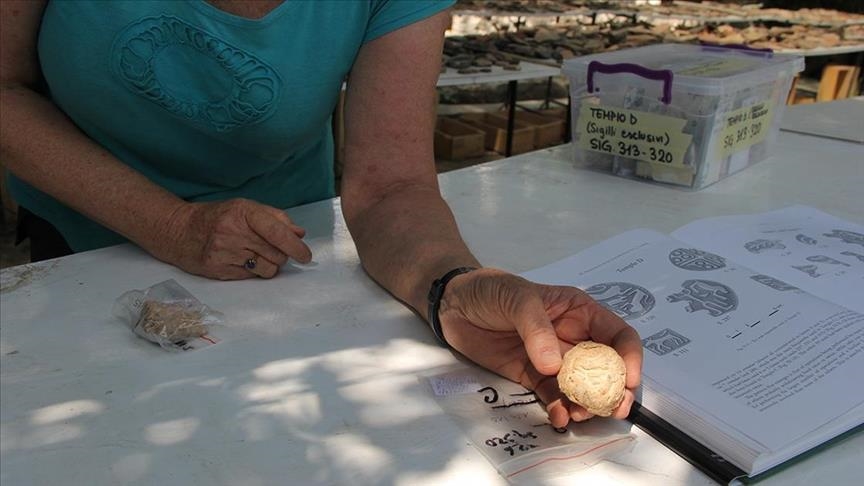
MALATYA, Turkey
Archeologists are tracing ancient seal impressions found in the roughly 7,000-year-old Arslantepe Mound in Turkey’s eastern province of Malatya to understand how bureaucracy was born.
Seal impressions found in excavations at the mound, which is on the UNESCO World Cultural Heritage Permanent List, shed light on the bureaucratic structure of the period.
While excavations continue full speed at the site, an analysis is being carried out of 250 seal impressions found a few years ago in a 5,621-year-old temple in the area.
Marcella Frangipane, a professor of archaeology at the Sapienza University of Rome, retired after directing the excavations at the mound for 30 years.
Frangipane told Anadolu Agency that during the excavations at the site in the mud-brick palace, known as the world's first royal palace, they found a total of 5,000 seal impressions and that they read them through reconstructions and published them in a book titled Arslantepe.
Noting that she came to Malatya to work on a new book this year, Frangipane said they will examine the 250 seal impressions they found a few years ago from a temple dating to an earlier period than the palace.
“We found a temple a few years ago. That temple is older than the palace, dating back to 3,600 BC,” she said.
Pointing out that 200-250 seal impressions were found inside the temple, Frangipane said: “This year, we are working on these seal impressions. Hopefully, it will be a good book, the science will be more complete.”
“Now we know that the bureaucracy started before the palace. It was more sophisticated in the palace time. This is very important,” she added.
Highlighting that they could not find any seals in the excavations until now, but only found seal impressions, Frangipane said: “We are doing a very careful job. We look at everything with a microscope. Now we can reconstruct.”
“What we understand from the prints is that there were stone, metal and wooden seals. There are no wooden seals left in archeology, but we know [about them] from the prints,” she added.
Lions, snakes and human figures
On the details of the 5,000 seal impressions in which scientific work was completed, Frangipane said: “We found seals with lions, snakes and human figures. There are different patterns. We are looking at what they sealed with the seal -- vases, bags, baskets, doors. We could not find the seal on the door in the temple. It was in the palace.”
“It means there was control. The warehouses were controlled. In the temple, there were seal impressions for baskets, bags and vases. So a few things changed over time. It's also very important. Arslantepe shows a very important method for this. Over the years, the system has gotten better,” she added.
The head of the Arslantepe Mound excavation associate professor Francesca Balossi Restelli, said the 5,000 seal impressions they found in the palace on the mound are very important for the archive.
Noting that these impressions explain the state administration, Restelli said: “It takes very subtle and very slow work to understand these seal impressions, because we will trace the seal from the impressions. We will look so we can understand the style of the seal.”
“We did not find any seals in the excavations because the seals are inside the houses. But we found a palace. There are no seals inside the palace, they have impressions,” she said.
“As we looked at the impressions, we understood the seals. We found 250 seal impressions in the temple. Each seal means a person, so there were 250 families here. There were people and they were connected with the palace. They worked in the palace. They were officials,” she said.
Restelli said that during the excavations this year, they found houses from the late Chalcolithic period, dating back to 3600-3700 BC.
“We hope we can understand how this important system [bureaucracy] was born from these houses.”
Arslantepe – meaning “Lion Hill” – has been on the UNESCO World Heritage Tentative List since 2014.
The archaeological site of Arslantepe is located on the Malatya plain, 5 kilometers (3.1 miles) from the city center and 15 kilometers (9.3 miles) from the Euphrates River, according to UNESCO’s website.
“It is a four-hectare and 30-meter-high archaeological mound dominating the plain and formed by the superimposition of settlements for millennia, from at least the 6th millennium BCE to the late Roman period,” said UNESCO.
Anadolu Agency website contains only a portion of the news stories offered to subscribers in the AA News Broadcasting System (HAS), and in summarized form. Please contact us for subscription options.

